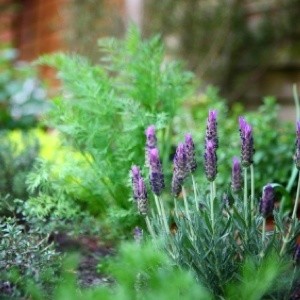
If you've ever wanted to plant an herb garden, perennials herbs are the way to go. Not only do they contribute a fresh supply of flowers, fragrance and herbs year after year, once perennial herbs gardens become established they require very little maintenance. Here are some tips for getting started.
When choosing a site for your herb garden, keep in mind how you intend to use your herbs. For example, a garden full of culinary herbs should be placed as close to the kitchen as possible to make frequent harvesting easy. If space is limited, consider raising some herbs in containers.
Most herbs need a site that gets at least 6 hours of sunlight every day. The following tolerate partial shade: rosemary, scented geraniums, agrimony, angelica, bay, bee balm, catnip, chamomile, comfrey, costmary, feverfew, germander, ginger, horsetail, hyssop, lemon balm, lovage, mint, pennyroyal, sweet cicely, sweet woodruff, tansy, tarragon, thyme, valerian, violet, and wormwood.
Perennial herbs are long-lived, so when planting them make sure small plants have plenty of room to spread out. Try to plant herbs together according to their growing requirements, not according to their use. Beware of herbs like mint (including peppermint and spearmint) and comfrey that can become highly invasive. Plant them in underground clay pots to prevent them running rampant.
Most herbs do best in light, well-drained soil and require only a moderate amount of soil fertility. Amend heavy soils or use raised beds or containers to compensate for less than ideal conditions. Drought tolerant herbs include lavender, rosemary, sage, and thyme. Herbs suitable for damp sites include agrimony, mint, and valerian.
As you choose perennial herb plants, consider your personal taste, what you want from them, and the growing conditions you have available. You may also want to add in some annual or biennial herbs, such as basil, calendula, dill, fennel, or parsley.
Examples of herbaceous perennials: Agrimony, aloe, angelica, anise, arnica, bee balm, betony, burdock, catnip, chamomile (Roman), chicory, chives, clary, comfrey, costmary, dandelion, dock, feverfew, garlic, germander, ginger, goldenrod, hop, horehound, horseradish, hyssop, lavender (English), lemon balm, lemongrass, lovage, marjoram, marsh mallow, mint, mugwort, nettle, oregano, pennyroyal (English), saffron, sage, savory (winter), soapwort, sorrel, sweet cicely, sweet woodruff, tansy, tarragon (French), thyme (garden), valerian, violet, wormwood, yarrow.
Examples of woody perennials: Barberry, bay (sweet), bearberry, birch, cascara sagrada, coffee, geranium (scented), lemon verbena, passionflower, rosemary, roses, sassafras, and witch hazel.

About The Author: Ellen Brown is an environmental writer and photographer and the owner of Sustainable Media, an environmental media company that specializes in helping businesses and organizations promote eco-friendly products and services.
Add your voice! Click below to comment. ThriftyFun is powered by your wisdom!
A great article. There is nothing better than adding fresh herbs to food. Plus herbs can be grown in containers on a patio or indoors under lights, giving just about everyone the chance to enjoy these wonderful plants.
Add your voice! Click below to comment. ThriftyFun is powered by your wisdom!